We are pleased to present the following winners of the 2019 Big Apple Brownfield Awards.
Supportive/Affordable Housing: Reaching New Heights Residence and the Apartments at Landing Road, Bronx, NY
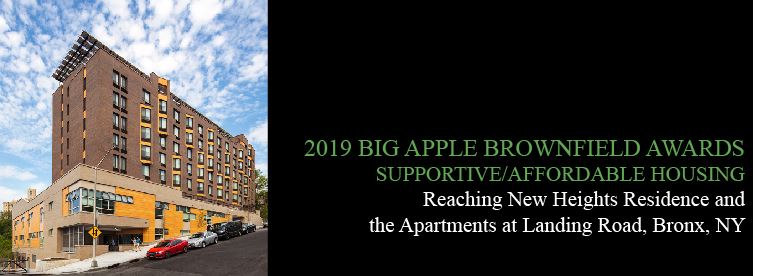
The 2019 Big Apple Brownfield Award for Supportive/Affordable Housing is presented to Reaching New Heights Residence and the Apartments at Landing Road located in the Bronx. The development team, comprised of Bowery Residents’ Committee, Edelman Sultan Knox Wood Architects, GZA Geo-Environmental, and Leonard J. Strandberg and Associates, created a game-changing building that combines permanent affordable housing and a shelter for the homeless in one project. By co-developing a shelter and housing facility in one effort, Bowery Residents’ Committee has created a new paradigm in shelter creation, while also addressing the affordable housing issue. The group is using the surplus revenue paid by the city to operate the shelter part of the building and reinvest it by subsidizing the rents of the housing portion’s units above, effectively tackling two problems at once. This once vacant lot, which was remediated through OER’s E-Designation program, is now a lovely building that all residents are proud to call home.
BOA Connectivity: Pitkin-Berriman, Brooklyn, NY

The 2019 Big Apple Brownfield Award for Brownfield Opportunity Area Connectivity is presented to the Pitkin-Berriman development located in the East New York neighborhood of Brooklyn. Developed by Cypress Hills Local Development Corporation, a 35-year-old community-based organization, this formerly vacant lot was transformed into a seven-story, mixed-use building with 60 affordable housing units, a senior day center, ground floor community space, and open space comprised of a playground, gardens, and walkways. The building is located within the East New York BOA, and as part of community engagement, CHLDC identified local residents’ priorities and concerns through a satisfaction survey completed by 623 local residents at numerous events. The survey responses, which endorsed the construction of affordable housing units and community centers, provided the basis for two community visioning events, dubbed the Verde Summit, and ten community meetings. The project team, which also included Heitler Houstoun Architects, worked with the Dept. of City Planning to rezone the site and with OER to remediate the site through their Voluntary Cleanup Program.
Community Outreach: Melrose Commons Supportive Housing, Bronx, NY
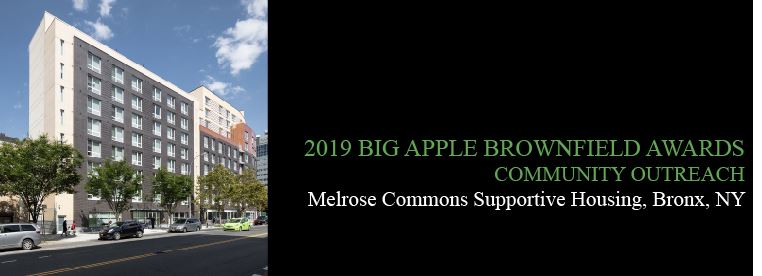
The 2019 Big Apple Brownfield Award for Community Outreach is presented to Melrose Commons Supportive Housing located in the Morrisania section of the Bronx. This previously abandoned property was developed into a nine-story permanent supportive housing building by The Bridge, one of NYC’s most experienced and comprehensive human services organizations. The new building’s 58 fully-furnished studio apartments house formerly homeless adults with special needs including veterans. A large multi-purpose room is used for socialization, cooking, and nutrition classes, and raised planter boxes in the rear yard are used for a horticultural training program. We reach out to fill job positions to qualified community residents and post open positions with Community Board 3 and local community organizations. Throughout planning and construction, the project team, consisting of The Bridge, Magnusson Architecture and Planning, The J. Pilla Group, A. Larovere Consulting, Sherman Law, AKRF, and Bright Power, successfully navigated OER’s E-Designation program and embraced green development, which resulted in the receipt of an Enterprise Green Communities grant and Reso A funding from the Bronx Borough President.
Economic Development: Oak Point Property, Bronx, NY
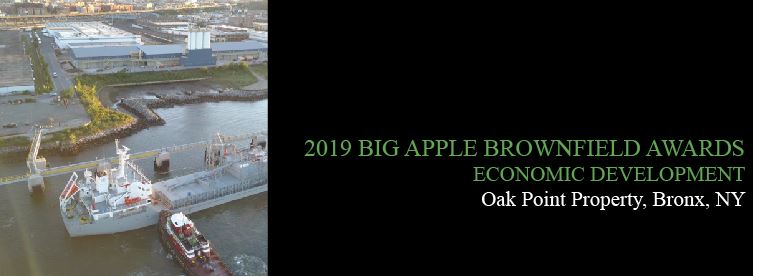
The 2019 Big Apple Brownfield Award for Economic Development is presented to Oak Point Property located in the Bronx. The team responsible for transforming this once illegal dumping ground into a state-of-the-are commercial property with a 2.5-acre waterfront nature preserve and greenway, includes Steve Smith of Oak Point Property LLC, Ken Cohen of Pantheon Properties, Land Use Ecological Services, Phillip Habib & Associates, Stanley Fleishman with Jetro/Restaurant Depot, McInnis USA, Ana Lavdas of AAL Construction Services LLC, and TRC Environmental Corporation. Construction of the site bolstered the local economy by creating upwards of 300 short-term jobs. This economic development is sustained by the creation of over 200 permanent jobs at the Jetro/Restaurant Depot facility and the McInnis USA 24/7 operational cement terminal. Prior to opening the commercial properties, the first round of employment opportunities were extended to the local community including many veterans who now hold living-wage jobs at the cement terminal. In addition, truck traffic in the community is decreasing as the cement terminal delivers 90% of its product via ships. The shoreline greenway encompasses a portion of the Magic Mile, which is a proposed one-mile waterfront walkway with space for exercise, quiet reflection, fishing, games, historic exploration, and water activities. NYSDEC oversaw remediation of this once defunct and now thriving property.
Environmental Protection: Former Liberty Brass (The Sunnyside), Long Island City, NY
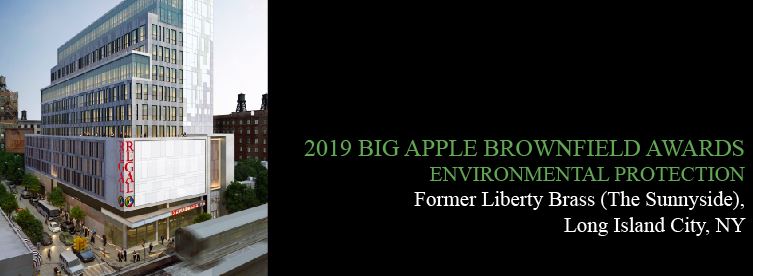
The 2019 Big Apple Brownfield Award for Environmental Protection is presented to Former Liberty Brass, aka the Sunnyside, located in Long Island City. Extraordinary measures were taken to remediate this former brass fitting manufacturing plant in Sunnyside to achieve a conditional Track 1 cleanup within the New York State Brownfield Cleanup Program. The cleanup resulted in the removal and proper disposal of approximately 30,000 tons of material. Challenges included the excavation of several deep hot spots of TCE-contaminated soil to the limits of technical practicability and the installation of an upgradient reactive barrier and source area in-situ chemical oxidation injections during the latter stages of the project. The success of this project may be attributed to great communication among the project team and with NYSDEC to ensure that the remedial requirements were achieved to ensure a conditional Track 1 cleanup. Through carful coordination, the project team comprising Curbcut Queens Boulevard, PW Grosser, Knauf Shaw LLP, and Sordoni Construction, transformed a vacant manufacturing building into a 12-story commercial building, which houses a Regal Theaters multiplex cinema, as well as, 100,000 square feet of office space that will be leased to medical and non-profit tenants.
Green Building: 3365 Third Avenue, Bronx, NY
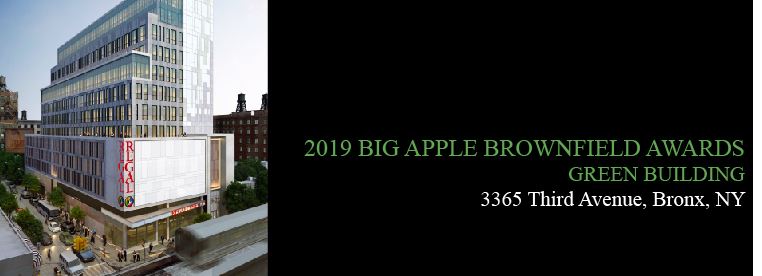
The 2019 Big Apple Brownfield Award for Green Building is presented to 3365 Third Avenue located in the Morrisania section of the Bronx. Developed by Bronx Pro Group, this will be the Bronx’s first certified Passive House project. The new eight-story, mixed-use building, which includes 30 affordable rental units and an early childhood education center, will have an energy reduction savings up to 90% when compared to conventionally-built structures. The design and construction of the building, by Curtis + Ginsberg Architects and C&S Construction, respectively, minimized environmental impacts and embraced green alternatives, which led the building to achieve a LEED Platinum rating. In addition, AKRF oversaw remediation of the site through OER’s Voluntary Cleanup Program. In large part to the Bronx Pro Group’s commitment to transitioning the Morrisania section of the Bronx from industrial use into a mixed-use community, a once vacant lot is now a beautiful new building that will serve the neighborhood for years to come.
Distinguished Award Winner – Dan Walsh
 Dan grew up in Rockland County, N.Y. He graduated with a geology degree from Binghamton University and after a short time playing minor league baseball, Dan started his career at Columbia University’s Lamond Doherty Observatory. He then took a position as staff scientist at LMS Engineering collecting aquatic and benthic samples on the Hudson River and New York Harbor for environmental impact studies.
Dan grew up in Rockland County, N.Y. He graduated with a geology degree from Binghamton University and after a short time playing minor league baseball, Dan started his career at Columbia University’s Lamond Doherty Observatory. He then took a position as staff scientist at LMS Engineering collecting aquatic and benthic samples on the Hudson River and New York Harbor for environmental impact studies.
Dan met his wife Jeanne while working on the Hudson River and they were married in Nyack, NY. They have a son, Zachary Hudson Walsh. After graduating from UMass with a M.S. in hydrogeology and geophysics, he took at job with DEC working at the World Trade Center as a geologist. He was responsible for cleanup of hazardous and solid waste sites and petroleum spills in NYC and he led the cleanup of the Fresh Kills Landfill for DEC. Dan estimates that he has been involved in approximately 10,000 land cleanup projects in NYC in his career.
He obtained a Ph.D. from RPI in geochemistry where he studied the history and chemistry of landfills in NYC and took an adjunct appointment to the faculty at Columbia (Lamont). While serving as director of the NYC Solid Waste Division for DEC, on September 11, 2001, he was appointed Chief of Operations for NY State’s environmental response to the World Trade Center disaster. He served on that project for its entire 11-month duration. He resumed work for DEC as director of the NYC Superfund and Brownfield Program and played an active role in implementing the NYS 2003 Brownfield Law and launching the state Brownfield Cleanup Program.
In 2008, Dan was appointed by Mayor Michael Bloomberg as founding director of the Mayor’s Office of Environmental Remediation. After working to establish the NYC Brownfield Law in 2009 and a landmark agreement with DEC on state authority delegation to NYC, his office founded the NYC Voluntary Cleanup Program in 2010. This program is the only city-run land cleanup program in the U.S. and during his tenure the VCP became the second most productive brownfield cleanup program in the U.S., behind only California state in number of projects completed. In 10 years at OER, he founded several novel urban programs, including the NYC Clean Soil Bank, the NYC Green Property Certification, the NYC Brownfield Partnership, SPEED and EPIC. Dan is indebted to the many superb staff members who he has served with at OER and DEC, including his colleague of over 30 years, Shaminder Chawla.
In 2018, Dan left government service to expand his academic research, teaching and work with students at Columbia University and to establish a consulting firm that provides advisory services on land remediation and reclamation and materials management. He remains a national advocate for municipal environmental governance and serves in various science advisory roles including USEPA and 100 Resilient Cities.
The NYC Brownfield Partnership Would Like to Thank…
EVENT PARTNER:
Baruch College
PLATINUM EVENT SPONSORS:
- Brown Duke & Fogel, PC
- GEI Consultants, Inc.
- Oak Point Property
GOLD EVENT SPONSORS:
- Alpha Analytical
- AWT Environmental Services
- Brookside Environmental
- Brownfield Coalition of the Northeast
- Clean Earth
- Roux
SILVER EVENT SPONSORS:
- AKRF
- Pine Environmental
- PVE
- PWGC
- Ramboll
- Rigsby Search Group, LLC
- Riker Danzig Scherer Hyland Perretti
- Schnapf Environmental Law
- Sordoni
- Tenen Environmental
- vEKtor Consultants
- York Analytical Laboratories
AFTER-PARTY SPONSORS:
- Capitol Environmental Services
- Langan